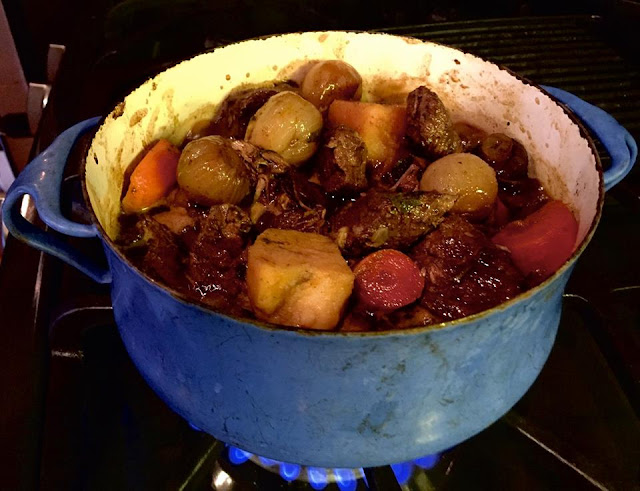It was because the neighbors made such a fuss coming over when my mother cooked stew and asking for the recipe that the stew grew larger than life. I greeted the gravy soaked potatoes and carrots with pleasure. I’d line them up on my plate and mash them into piles, melting margarine on top to make them richer. My mother loved the onions but I didn’t and I was neutral on the celery. The meat was a crapshoot, some pieces were fall apart tender but the threat of hidden gristle or an endlessly chewy bit made each bite suspect.
She browned the meat first. She used cooking wine from the supermarket mixed with bouillon cubes for broth. She must have cooked it over the week-ends when she had more time. We’d eat it two or three times the following week. I’d sit at the table waiting, watching her discard shards of congealed fat from the surface of the chilled pot. Once defatted, she’d reheat the pot over a low flame and turn her attention to salad.
I don’t know the story behind the recipe, or if she took pleasure in the slow simmer that scented the house. Did she think “Damn I make good stew.” Did she sometimes think she was something raising kids on her own? Did she feel alluring and wish someone might fall for her because she could juggle, cope, and cook?
When I make stew I use carefully trimmed pasture-raised beef, good red wine, homemade broth, and I think all those things. Lighter, quicker cooking is more my style, but when I make stew I’m filled with hope.
My stew has never once matched the one that fed that awkward girl. I can see myself sitting in my mother's kitchen watching her every move, searching for cracks in her veneer—places levity or love might seep out. What I got was gravy soaked potatoes. My mother put in extra because she knew I liked them.
Stiffness and incremental loss of stability mixed with depression and the onset of dementia coalesced into the diagnosis of Parkinson’s. Year after year pieces of her disappeared. I’d sit with her, lining up food on her plate, mashing it into piles, feeding her with a spoon, hoping the food might wake her senses. She was trapped inside herself, slogging through a tangle of memories, or maybe they were drug induced hallucinations. I thought if I listened carefully enough I’d figure out what her broken sentences meant. I liked to think I had a knack that could break though her isolation.
Now, cooking and eating her stew to write these words, the memory of the girl at the table watching her mother cook, and the woman feeding her mother, merge. I'm realizing how much time I spent waiting, watching and waiting, hoping for something that wasn’t there. The food was there, but it didn’t fill me. It couldn’t fill her.
One common storytelling trope is the quest story. When its a food story the protagonist tastes something and the flavor rekindles something lost. In the story a single bite transports an eater across time and a kind of magic takes place where the food and the thing lost become one. I cook my mother’s stew over and over. I am a better cook than she was and my stew is excellent. It tastes of what wasn’t there.
Beef Stew
3 # Chuck steak
1 large onion, peeled and cut in half
1/2 # Crimini mushrooms
3 c. homemade broth
1 c. red wine
bay leaf, thyme, 4-5 garlic cloves, salt, pepper
2 T tomato puree
1/2 # carrots—peeled and cut into large chunks
1/2 # each: Japanese turnips and shallots—peeled and left whole
1# potatoes—peeled and cut into 2” chunks
2 stalks celery, chopped into 2” pieces
Use a thick Chuck steak rather than the pre-cut stew meat. Trim away thick veins of gristle and the thickest of the fat. Sear the steak in a super hot skillet sprinkled with a big pinch of salt—approx 3-4 minutes per side—long enough to brown the surface of the meat. Move to a cutting board and let rest. In the same skillet sear the peeled onion until there are bits of char on the surface. Set onion aside. Sear mushrooms until they give up their water. Set aside. Deglaze pan with wine, scraping up any browned bits. Reduce wine to around 3/4 c.
Preheat oven to 300
Cut seared meat into 2” chunks.
Put onion, celery, mushrooms, red wine, bay leaf, thyme, tomato puree and broth in an
oven-proof stew pot. Bring to a boil. Add beef and a sprinkle of salt and pepper. The broth should not quite cover the beef.
Partially cover pot and transfer to oven for an hour and a half.
Add carrots, turnip, potatoes and another sprinkle of salt and pepper. Add a little more broth if needed. Roast, partially covered for another hour or until the vegetables and meat are fork tender.

No comments:
Post a Comment